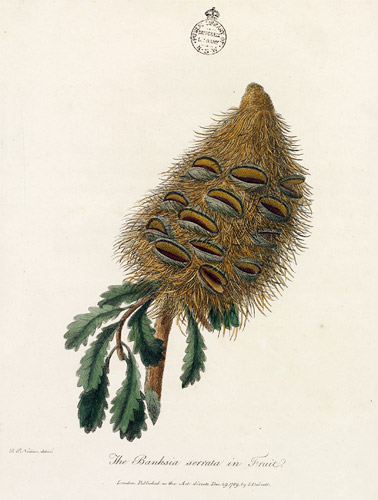Australian flora in England
Europeans were first introduced to images of Australian plants when William Dampier published the journal of his voyage to New Holland in 1703. Three black and white engraved plates depicted plants gathered by his expedition from Western Australia.
> View the flora illustrated in Dampier’s 1703 Journal
The most important name in early Australian botany is undoubtedly that of Sir Joseph Banks. He was one of the botanists on Captain James Cook’s 1770 voyage to Australia in Endeavour. Banks, assisted by Daniel Solander, collected tens of thousands of specimens which were painstakingly recorded on board the ship by botanical artist Sydney Parkinson. Over a thousand new species were identified from this voyage alone. Despite plans for a lavishly illustrated publication based on Parkinson's beautiful illustrations, Banks’ work on the Cook specimens was not published until more than one hundred years later. The copper plates were bequeathed by Banks to the British Museum, which finally issued all 745 plates of Banks' Florilegium in the 1980s.
Joseph Banks was a passionate advocate for settlement in Botany Bay, and his encouragement was vital when the British government was deciding on the location for a new penal settlement. Banks maintained his interest in the natural history of the new colony, sponsoring new expeditions and continuing his studies into the new plants sent back from Australia. He was the main supporter of the Matthew Flinders’ scientific expedition in 1801 which included botanists Ferdinand Bauer and Robert Brown.
> View Ferdinand Bauer’s illustrated plates for Robert Brown’s Prodromus Florae Novae Hollandiae …
With the establishment of the penal colony at Port Jackson in 1788, European interest in the strange flora and fauna of New Holland remained high. More and more material was arriving from the colony to form the vast Australian collections of dried specimens at the London Natural History Museum. Botanists such as James Smith began to work on describing the new species. Acclaimed botanical artist James Sowerby illustrated several of Smith’s publications.
> Examine a selection of beautiful plates from Smith & Sowerby collaborations

Living plants and seeds were also collected by explorers and naturalists from their native Australia. Those that survived the long voyage back to England were prized by nurseries and private enthusiasts. One of the biggest and most diverse collections of living plants was found at Kew Gardens. The plants which flourished there were a rich source of inspiration and study for artists and scientists.
> Explore printed illustrations of Australian plants in publications linked with Kew Gardens from the early 1800s
After about 1840, garden tastes changed in England and Australian plants were no longer as popular as they had been. This, along with the finanical ravages of the Napoleonic wars in the early part of the century, meant that the market for lavishly illustrated books on Australian botany declined rapidly. Although collecting of Australian plants and seeds continued for scientific purposes, Australian flora and floral publications never again attained the popularity they had enjoyed at the turn of the 19th century.





